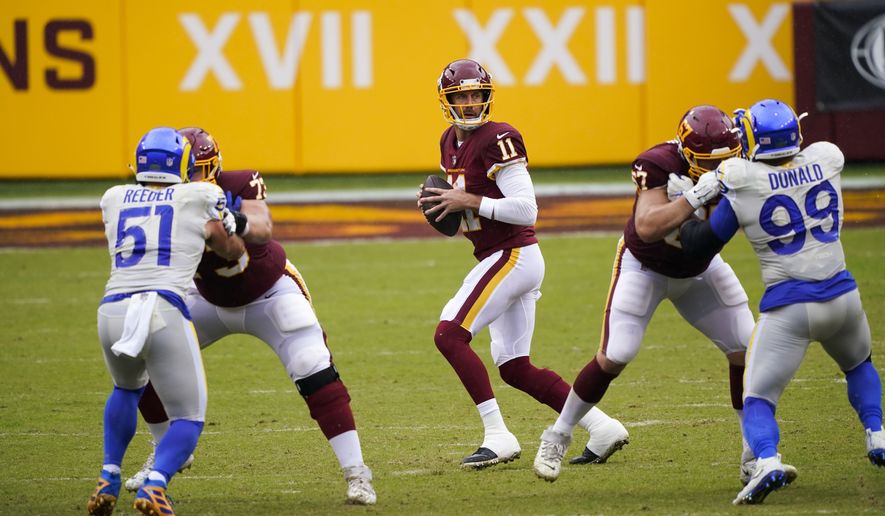If Alex Smith would have just taken one rep Sunday, there would still be a solid case the 36-year-old quarterback would have deserved the NFL’s comeback player of the year award. But after playing 29 snaps?
Just give him the award now.
After 693 days and 17 surgeries on his broken leg, Smith made his return to the field for his first football game in nearly two years in Washington’s 30-10 loss to the Los Angeles Rams. He did so after staving off an infection that nearly cost him his leg — and his life. There’s now a titanium rod in Smith’s leg, strong enough to help the veteran withstand the six sacks he took against the Rams.
Most, including Smith at times, thought he was done.
“I always felt like when I had my darkest moments there was always something around the corner that happened that I just kept plugging along, then all of a sudden I made a big gain or a big step or something clicked and I just kept marching,” Smith said. “I felt like it would repeat itself, then all of a sudden, I’d make another jump.”
After Sunday’s loss, Smith said he had a bitter taste in his mouth for his performance — just 9 of 17 for 37 yards — but his comments downplay the significance of how rare it is for an athlete to make such a return.
A day after it finally happened, it’s fair to wonder where Smith ranks among the greatest comebacks of all time. Somewhere behind Muhammad Ali and George Foreman, for sure. Michael Jordan is another who came back as good or better from time away. But Smith’s amazing recovery from a shattered leg deserves a spot in the discussion.
Here’s who on the mantle:
Muhammad Ali: Ali sacrificed three-and-a-half years of his prime to take a stand against the Vietnam War. By refusing to be drafted, boxing commissions refused to sanction Ali from 1967 until 1970 — when the heavyweight great was cleared to return by the Atlanta Athletic Commission. Upon his return, Ali would go on to win some of the biggest fights of his career — Joe Frazier, Foreman, Ken Norton — and solidify his resume as one of the best boxers of all-time.
George Foreman: Ten years. That’s how long Foreman went between bouts before he announced he was returning the ring at age 38. What’s remarkable, even now, about Foreman’s return is how long it lasted. Foreman fought another 34 fights across 10 years before retiring for good in 1997. Foreman’s crowning achievement is his 1994 tenth round knockout of Michael Moore that made him the oldest heavyweight champion of all time at 45.
Michael Jordan: In case anyone forgot Jordan’s greatness, “The Last Dance,” ESPN’s 10-hour Jordan documentary, was the perfect reminder to show what “His Airness” was capable of. After taking a year-and-a-half off to pursuit baseball, Jordan returned to lift the Chicago Bulls to another 3-peat. Jordan voluntarily stepped away in 1993, so his return may not be as dramatic as some of the other all-time great comebacks. But he was dominant nonetheless.
Ted Williams: The Boston Red Sox Hall of Famer’s list of accomplishments is long and well-earned. But perhaps the most impressive aspect of Williams’ career is that he did so despite serving in World War II and the Korean War as a member of the U.S. Navy and the Marine Corps. After batting .406 in 1941, Williams was drafted in the military — putting his MLB career on pause until 1946, when he won his first MVP award. He was also called to serve in the Korean War in 1952, returning to baseball in August 1953.
Magic Johnson: Johnson abruptly retired in 1991 when he shocked the world in announcing his HIV diagnosis. Though Johnson was a member of the 1992 Dream Team at the Barcelona Olympics, Johnson’s true bid to finish his career happened in 1996 when he attempted a comeback with the Los Angeles Lakers. Johnson’s numbers weren’t gaudy as he averaged 14.6 points per game. But his season helped fight the stigma of contracting HIV.
Mario Lemieux: Lemieux had two unbelievable comebacks for the Pittsburgh Penguins. The first was when he overcame Hodgkin’s Lymphoma in 1992 and led the Penguins to win 17 straight victories after his two-month hiatus to finish out the season. Then, in 2000, Lemieux came out of a three-year retirement to rejoin the Penguins and play until 2006. Here’s a fun fact about the latte: Lemieux was — and still is — the Penguins’ controlling owner, purchasing the team in 1997.
Monica Seles: In 1993, Seles was stabbed by a fan during the middle of a match. Ranked the world’s No.1 female tennis player at the time, Seles didn’t return to tennis until 1995 and won his first comeback tournament. She won the Australia Open in 1996, her first Grand Slam title since the incident.
Tiger Woods: Woods may have not had the inactivity of someone like Ali or Foreman, but his fall from grace was fast and hard. In 2009, Woods was caught cheating on his wife with multiple women and a slew of injuries derailed his career. Once the most dominant golfer of his generation, Woods went 11 years without winning a major. But that changed in 2019 when Woods rallied to win that year’s Masters.
Michael Vick: Some people will never forgive Michael Vick for his role in a dog-fighting ring, which led the quarterback to serve two years in prison. Still, Vick’s success with the Philadelphia Eagles upon his release was unexpected. After spending one year as a backup in 2009, Vick seized control of the Eagles’ starting job with an electric season in 2010 that included a six-touchdown performance against Washington. He was named the comeback player of the year that season, as well.
• Matthew Paras can be reached at mparas@washingtontimes.com.




Please read our comment policy before commenting.